Ghost in the Shell 2: Innocence
6.8 /10 1 Votes
64% Rotten Tomatoes Country Japan | 7.6/10 IMDb 66% Metacritic Genre Animation, Drama, Sci-Fi Duration Language Japanese | |||||||||||||||||||||||||||||||||
 | ||||||||||||||||||||||||||||||||||
Release date Japan: March 6, 2004US: September 17, 2004UK: October 28, 2005 Writer Masamune Shirow (comic "Koukaku-Kidoutai"), Mamoru Oshii (screenplay), Richard Epcar (english version) Film series Ghost in the Shell Film series Cast (Motoko Kusanagi (voice)), Akio Ôtsuka (Bat? (voice)), Kôichi Yamadera (Togusa (voice)), Christin Marquitan (Motoko Kusanagi (Stimme)), Tilo Schmitz (Bat? (Stimme)), Klaus-Peter Grap (Togusa (Stimme))Similar movies Terminator Genisys , Blade Runner , Lucy , Avatar , Terminator Salvation , Ex Machina Tagline When machines learn to feel, who decides what is human... | ||||||||||||||||||||||||||||||||||
Ghost in the shell 2 innocence trailer
Ghost in the Shell 2: Innocence, known in Japan as Mobile Armored Riot Police: Innocence (攻殻機動隊 イノセンス, Kōkaku Kidōtai Inosensu), is a 2004 anime/computer-animated science fiction sequel to the 1995 film Ghost in the Shell. Released in Japan on March 6, 2004, and in the US on September 17, 2004, Innocence had a production budget of approximately $20 million (approximately 2 billion yen). To raise the sum, Production I.G studio's president, Mitsuhisa Ishikawa, asked Studio Ghibli's president, Toshio Suzuki, to co-produce.
Contents
- Ghost in the shell 2 innocence trailer
- Plot
- Directors ideas
- Title change
- English language dub
- Soundtrack
- Novel
- Reception
- Problems with the foreign DVD releases
- Original voiceovers
- References
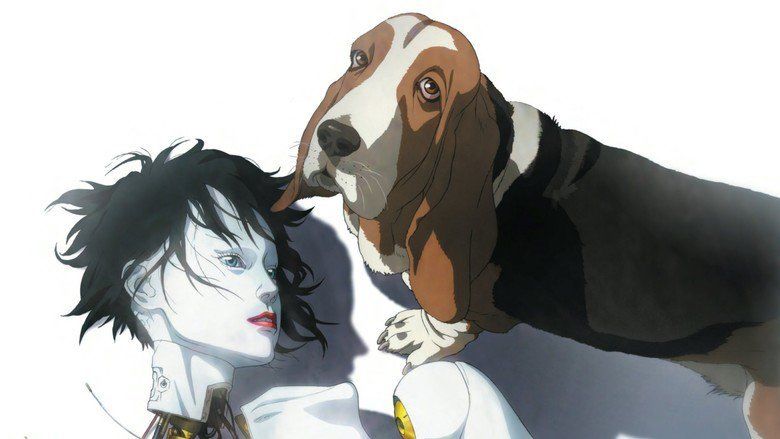
With a story loosely connected to the manga by Masamune Shirow, the film was written and directed by Ghost in the Shell director Mamoru Oshii. The film was honored best sci-fi film at the 2004 Nihon SF Taisho Awards and was in competition at the 2004 Cannes Film Festival. The soundtrack for the film was released under the name Innocence O.S.T. and a related novel called Ghost in the Shell: Innocence - After the Long Goodbye was released on February 29, 2004. This film makes many allusions and references to other famous works, such as The Future Eve. The foreign DVD release of the film faced many issues ranging from licensing to audio.
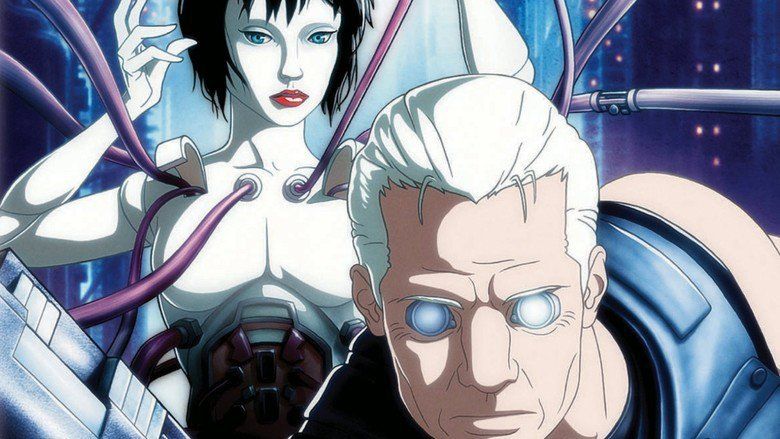
Plot

The story is loosely based on Ghost in the Shell manga chapter "Robot Rondo" (with elements of "Phantom Fund"). Opening in 2032, Public Security Section 9 cybernetic operative Batou is teamed with Togusa, an agent with very few cybernetic upgrades, following the events of Ghost in the Shell.
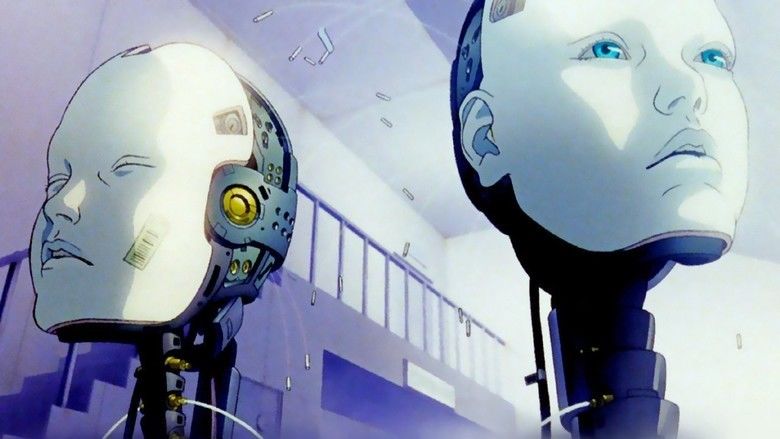
After a series of deaths due to malfunctioning gynoids—doll-like sex robots—Section 9 is asked to investigate. As the gynoids all malfunctioned without clear cause, the deaths are believed to be premeditated murders; Batou and Togusa are sent to investigate possible terrorist or political motives. Additionally, the most recent gynoid's remains show they all contained an illegal "ghost". Section 9 concludes human sentience is being artificially duplicated onto the dolls illegally, making the robots more lifelike, and possibly acting as a motive in the murders.

Called to a homicide scene, information warfare/technology specialist Ishikawa explains the victim is Jack Walkson, a consignment officer at gynoid company LOCUS SOLUS, who may have been killed by the Yakuza. A previous Yakuza boss was recently killed by a gynoid, so Ishikawa concludes Walkson was held responsible and killed in an act of revenge. Batou and Togusa enter a Yakuza bar to question the current boss, only to be threatened by the bar occupants. Batou opens fire, killing and wounding numerous gang members, including the cyborg that murdered Walkson. The current boss then admits his predecessor was somehow involved in LOCUS SOLUS, but insists he doesn't know how.
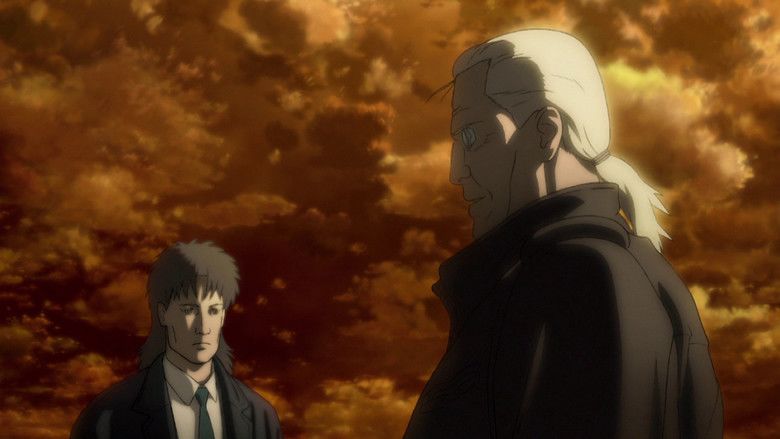
Entering a store on his way home, Batou is then seemingly warned by the Major and shot in the arm by an unseen assailant. Caught in a firefight, Batou nearly kills the store owner in confusion, but is subdued when Ishikawa appears. While having his damaged arm replaced, Batou is informed by Ishikawa that his e-brain was hacked, causing him to shoot himself and attack the store occupants. Ishikawa explains that Batou was hacked to try and cause further scandal following his Yakuza assault in an attempt to stop the Section 9 investigation.
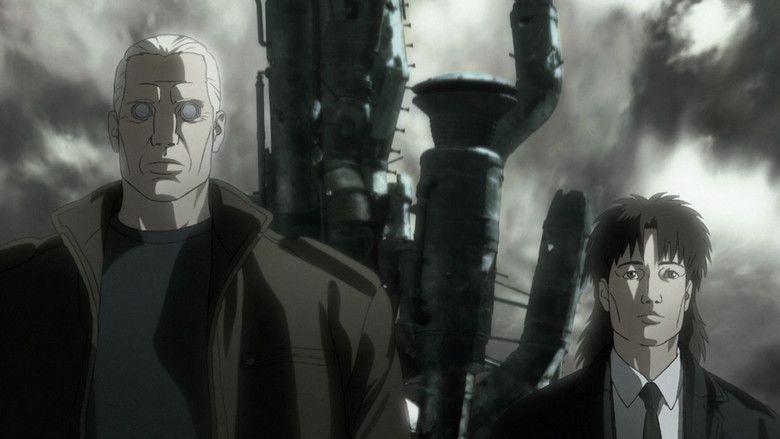
Batou and Togusa then head for the mansion of Kim, a soldier-turned-hacker with an obsession with dolls. Seemingly dead, Kim soon reveals he "lives" inside the shell of a human-sized marionette, and discusses philosophy with his visitors. Kim admits ties to LOCUS SOLUS, divulging that the company has secret headquarters in international waters. Warned again by the Major, Batou realizes that Kim has secretly hacked into his and Togusa's e-brains, and is currently trapping them in a false reality. Resetting Togusa's brain, Batou subdues Kim, noting he knows Kim hacked his brain in the store.
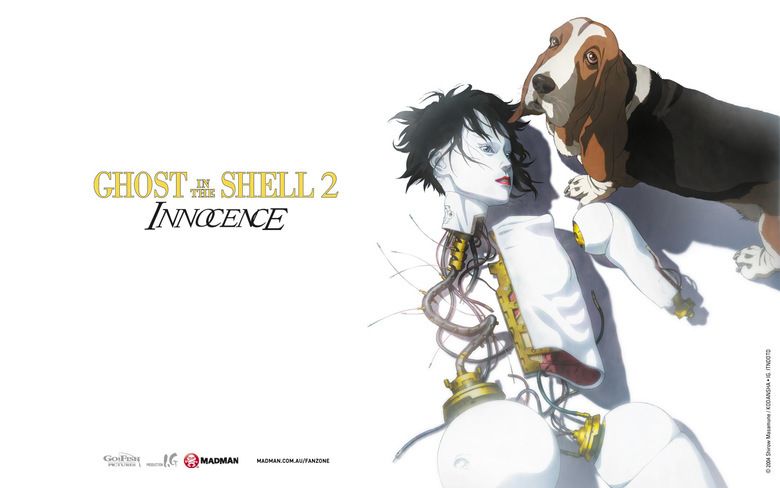
Resolved to gather material evidence, Batou infiltrates the LOCUS SOLUS headquarters ship while Togusa remotely hacks its security systems using an unaware Kim as a proxy. The ship's security becomes aware of the hacking and retaliates with a virus that fries Kim's cyberbrain. Simultaneously, a hidden virus loads a combat program into the production-line gynoids, causing them to attack everyone aboard. As Batou fights to the ship's center, the Major then appears by controlling a gynoid remotely, helping Batou fight the gynoids and hack the ship's security.
Taking control of the ship, the Major then reveals to Batou the truth about the gynoids. Hiring the Yakuza to traffick young girls, LOCUS SOLUS duplicated their consciousnesses into the gynoids, giving them human "ghosts" to make them more realistic. Batou rescues a young girl from a "ghost dubbing" machine, and she explains that Jack Walkson, learning the truth about LOCUS SOLUS, promised to save the girls by tampering with the ghosting process; this caused the gynoids to murder their owners, allowing Walkson to attract police attention and indirectly kill the Yakuza boss. Despite Walkson's actions saving the girls, Batou objects that he also victimized the gynoids as well, causing them severe distress by giving them damaged ghosts. Having solved the case, Batou asks the Major if she's happy now, and she notes that she'll always be beside him on the network, before disconnecting from the gynoid.
Director's ideas
On the origins of the movie, director Mamoru Oshii says he didn't envision it solely as a sequel to Ghost in the Shell. He said, "I had a dozen ideas, linked to my views on life, my philosophy, that I wanted to include in this film.... I attacked Innocence as a technical challenge; I wanted to go beyond typical animation limits, answer personal questions and at the same time appeal to filmgoers."
Oshii traveled the world in order to find inspirations for the film. Oshii based the appearance on the dolls created by Hans Bellmer he saw at the International Center of Photography in New York. He credited Jean-Luc Godard for the idea of including quotes by other authors: "[The texts] ... give a certain richness to cinema because the visual is not all there is. Thanks to Godard, the spectator can concoct his own interpretation.... The image associated with the text is a unifying act that aims at renewing cinema, that let's [sic] it take to new dimensions."
Oshii noted his attention to detail might be particularly Japanese: "I get absorbed in the finer points – like what the back of a bottle label looks like when you see it through the glass [demonstrates with a bottle of mineral water]. That's very Japanese, I suppose. I want people to go back to the film again and again to pick up things they missed the first time." Describing the overall look, the director said, "The film is set in the future, but it's looking at present-day society. And as I said, there's an autobiographical element as well. I'm looking back at some of the things I liked as a child — the 1950s cars and so on. Basically, I wanted to create a different world — not a future world."
The dog Gabriel, looking once more like the only "real" being, makes a key appearance, as in many of Oshii's movies. A scene with Batou feeding his dog is echoed in Ash in Avalon (2001). He explained the reason why all his films feature a basset hound—his companion in real life: "This body you see before you is an empty shell. The dog represents my body. Human beings can be free only if they free themselves from their bodies. When I am playing around with my dog, I forget that I am a human being, and it's only then that I feel free."
As for the state of art and animation, Oshii had this to say:
"I think that Hollywood is relying more and more on 3D imaging like that of Shrek. The strength behind Japanese animation is based in the designer's pencil. Even if he mixes 2D, 3D, and computer graphics, the foundation is still 2D. Only doing 3D does not interest me."
On the overall message of the film, the director said "This movie ... concludes that all forms of life – humans, animals and robots – are equal. In this day and age when everything is uncertain, we should all think about what to value in life and how to coexist with others." On his narrative intentions Oshii comments: "I had a bigger budget than for Ghost in the Shell. I also had more time to prepare it. Yet despite the economic leeway, abundant details and orientations, it was still important to tell an intimate story."
Title change
In order to better market the film outside Japan, the Ghost in the Shell 2 moniker was added to the title of the film, with Innocence becoming the subtitle. Some fans saw this as conflicting with Oshii's statements that the film wasn't, in actuality, a standard Hollywood-esque sequel, and was able to, and intended to, stand on its own.
English-language dub
When Go Fish Pictures released Innocence, they released it subtitled, without English dubbing, a controversial choice since every Ghost in the Shell anime released by Manga Entertainment outside of Japan had been dubbed. Anime News Network announced Manga Entertainment UK's co-production of an English dub with Madman Entertainment, their Australian distributor and longtime partner, and Richard Epcar's (the voice of Batou) Epcar Entertainment studio for the dubbing. This was the first dub Manga UK had produced since X in 1999 and the first dub Madman produced. This dub was released in the UK by Manga and in Australia by Madman Entertainment (using the Go Fish Pictures transfer). Bandai Entertainment created a second dub for the North American market using most of the voice actors from the Manga/Madman version making some changes to the cast and production team and using Animaze's studio.
Soundtrack
The soundtrack was composed by Kenji Kawai, who also did Ghost in the Shell soundtrack. As he expressed in the liner notes, he agreed with Mamoru Oshii that the soundtrack pattern itself somewhat after "would follow the music from the original film." Additionally, Oshii made specific requests for "a huge music box," a "jazzy theme," and a "reprise of the song 'Follow Me'".
The music box, heard in the "Doll House" tracks, was procured from Sankyo Shoji. Wanting it to sound as if played in a huge space, Kenji Kawai had the music box recorded in studio, and then played back in the underground quarry of Ohya with four speakers and two subwoofers, where it was recorded with eight microphones.
The minyoh singers chorus, heard in the "Chants" in the first movie, and in the "Ballade of Puppets" in Innocence, was expanded to include 75 performers, which proved challenging to record. The session lasted for 14 straight hours.
"Follow Me" is a reprise of a song originally interpreted by Demis Roussos in 1982. The music is based on Joaquín Rodrigo's Concierto de Aranjuez, with lyrics by Herbert Kretzmer and Hal Shaper.
Novel
A novel by Masaki Yamada called Innocence: After the Long Goodbye (イノセンス After the Long Goodbye) serves as a prequel, taking place just before the film and told from Batou's perspective as he surrounds his search for his dog Gabriel (Gabu). It was published by Tokuma Shoten on February 29, 2004, and the English-language version was published by Viz Media in the US on October 2005. Viz media later released a four-volume Ani-manga boxset on April 2005.
Reception
Innocence ranked 28th at the US box office earning $317,000 on its opening weekend in September 2004. Honored best sci-fi film at the 2004 Nihon SF Taisho Awards, the film was in competition at the 2004 Cannes Film Festival, only the sixth animated film to be featured at Cannes ever. Along with Persepolis, it was the only animated film to be screened in the official selection, competing for the Palme d'Or award that year. (The eventual winner was Fahrenheit 9/11.)
The movie was praised by Manohla Dargis of the New York Times, who wrote "Innocence doesn't just reveal a wealth of visual enchantments; it restates the case that there can and should be more to feature-length animations than cheap jokes, pathos and pandering." The movie holds a 65% rating on Rotten Tomatoes. Criticism of the movie rests upon a mixture of reasons. It is cited to be overly heavy on philosophical dialogue and thus hard to follow, and its ending has been described as weak and unmeaningful in the arc of character development. Helen McCarthy in 500 Essential Anime Movies praises the quality script and direction, stating that "it's a challenging film, but it's one of the best anime ever".
Problems with the foreign DVD releases
On December 28, 2004, DreamWorks (parent company of theatrical distributor Go Fish Pictures) released Innocence on DVD in the US. Reviews immediately began appearing on Amazon and other websites criticizing the movie's subtitle track: Instead of including the overlay subtitles from the theatrical release, DreamWorks produced the DVD subtitles using closed captioning, resulting in subtitles that intruded on the movie's visual effects. In addition to reading dialogue, audiences saw cues like "Footsteps..." or "Helicopter approaches..." After receiving numerous complaints, DreamWorks released a statement saying that unsatisfied customers could exchange their DVDs for properly subtitled ones, postage paid; and that version 4 already had the proper subtitling.
Manga Entertainment, which released and co-produced the first film and collaborated with Bandai Entertainment to release the TV series, released Innocence with an English dub featuring the same cast as the one used in Ghost in the Shell: Stand Alone Complex in the UK on February 27, 2006. The Manga UK dub was co-produced with long-time anime partner, Madman Entertainment who has distributed Manga UK titles in Australia since its founding in 1996. The UK English dub on the Region 1 Blu-ray disc features an audio error where the soundtrack has been pitch shifted down, resulting in unnatural sounding deep voices, and mechanical sound effects in slow motion. This is also present on the standard DVD.
Bandai Entertainment has released the film on Blu-ray and DVD in the US, with an English dub also featuring the cast used in Ghost in the Shell: Stand Alone Complex. Bandai had licensed the film for a short period from Paramount.
The controversy with licensing also affected its release in Australia. Although Madman licensed it through Go Fish Pictures, the English dub used is from Manga Entertainment, through which Madman have licensed all Ghost in the Shell properties. The licensing costs are extremely high due to two different licenses being in effect on the DVD release. It is unknown whether Madman will use the Manga Entertainment dub or the Bandai dub for the Blu-ray version.
Original voiceovers
References
Ghost in the Shell 2: Innocence WikipediaGhost in the Shell 2: Innocence IMDbGhost in the Shell 2: Innocence Rotten TomatoesGhost in the Shell 2: Innocence MetacriticGhost in the Shell 2: Innocence themoviedb.org
